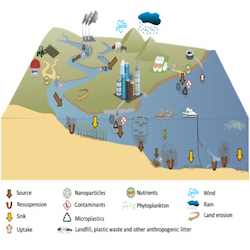ABSTRACT
Marine particles of all origins (biogenic, lithogenic, as well as anthropogenic) are fundamental components of the coastal ocean and are re-distributed by a wide variety of transport processes at both horizontal and vertical scales. Suspended particles can act as vehicles, as well as carbon and nutrient sources, for microorganisms and zooplankton before eventually settling onto the seafloor where they also provide food to benthic organisms.
Particle aggregation processes, driven by turbulence and particle stickiness, composition, abundance and size, impact the transport and sinking behavior of particles from the surface to the seafloor. In deep coastal waters, the deposition, resuspension, and accumulation of particles are driven by particle stickiness, composition and aggregate structure. In contrast, wave-driven and bottom current-driven processes in the nepheloid benthic boundary layer of shallow waters are of greater importance to the settling behavior of particles, while the retention capacity of benthic vegetation (e.g., seagrasses) further influences particle behavior. In this review, we consider the various processes by which particles are transported, as well as their sources and characteristics, in stratified coastal waters with a focus on Nordic seas.
The role of particles in diminishing the quality of coastal waters is increasing in the Anthropocene, as particle loading by rivers and surface run-off includes not only natural particles, but also urban and agricultural particles with sorbed pollutants and contaminants of organic, inorganic and microplastic composition. Human activities such as trawling and dredging increase turbidity and further impact the transport of particles by resuspending particles and influencing their vertical and horizontal distribution patterns.
An interdisciplinary approach combining physical, chemical and biological processes will allow us to better understand particle transport and its impact on coastal waters and estuaries at an ecosystem level. There is a need for development of novel analytical and characterization techniques, as well as new in situ sensors to improve our capacity to follow particle dynamics from nanometer to millimeter size scales.








